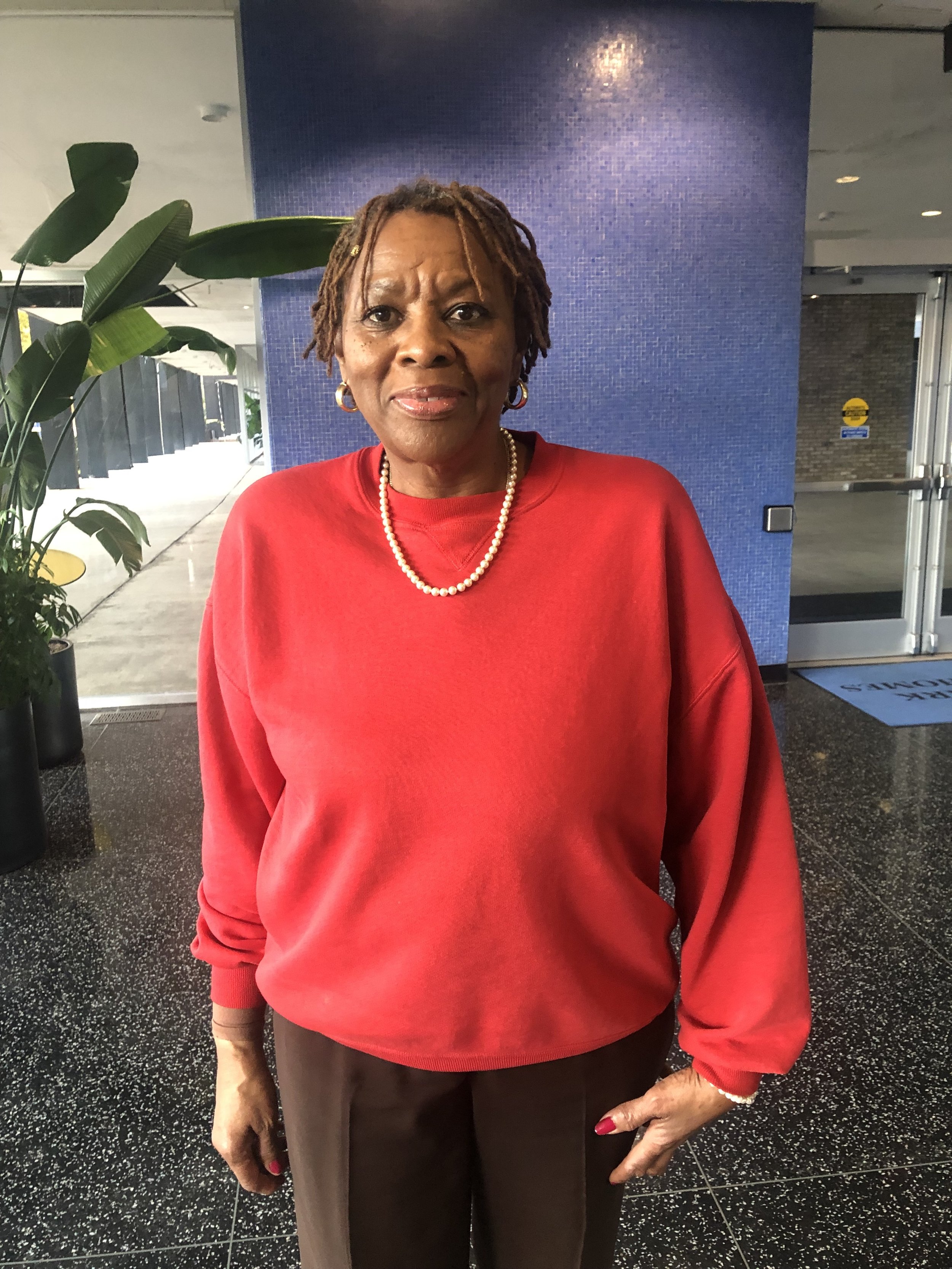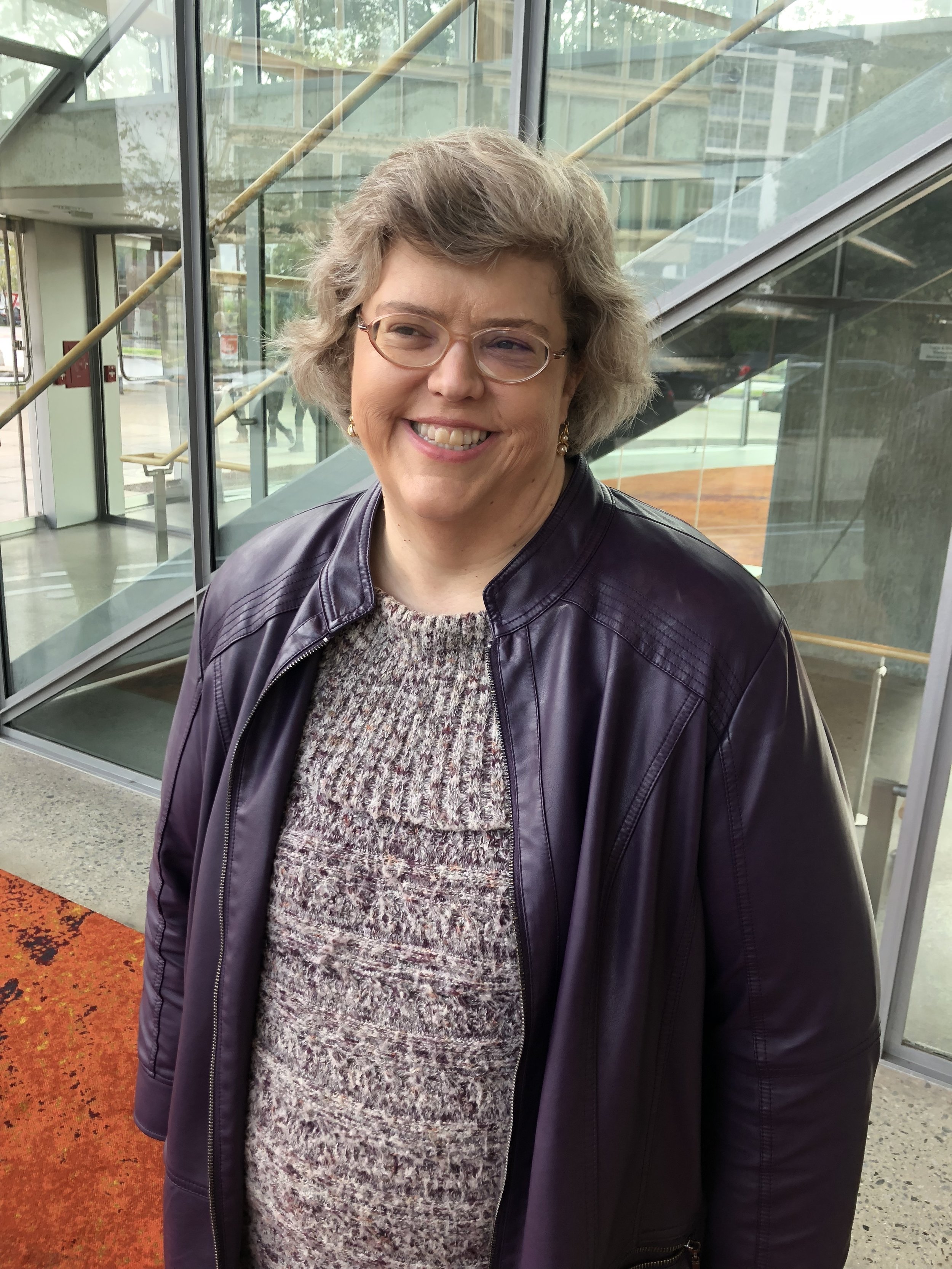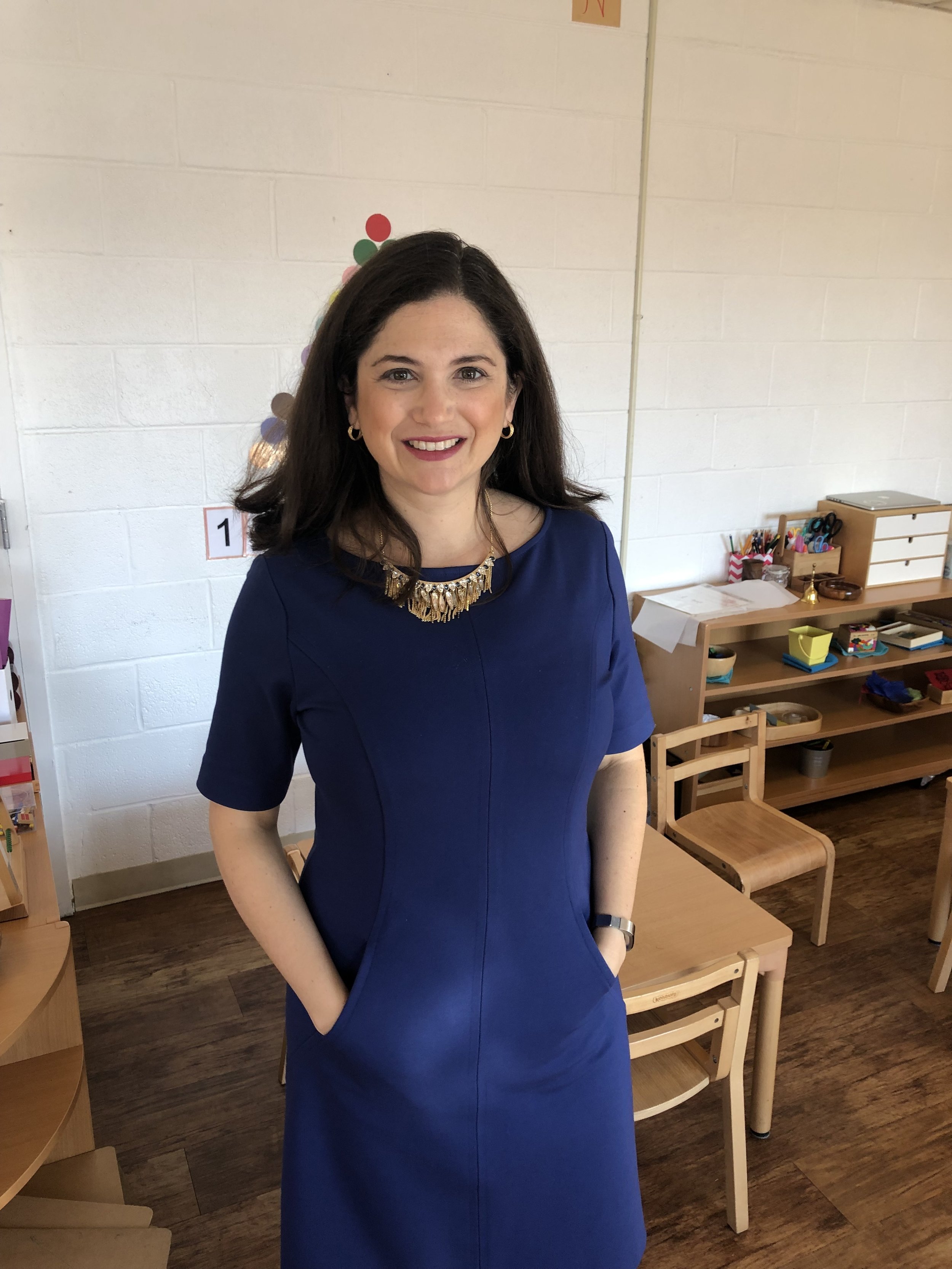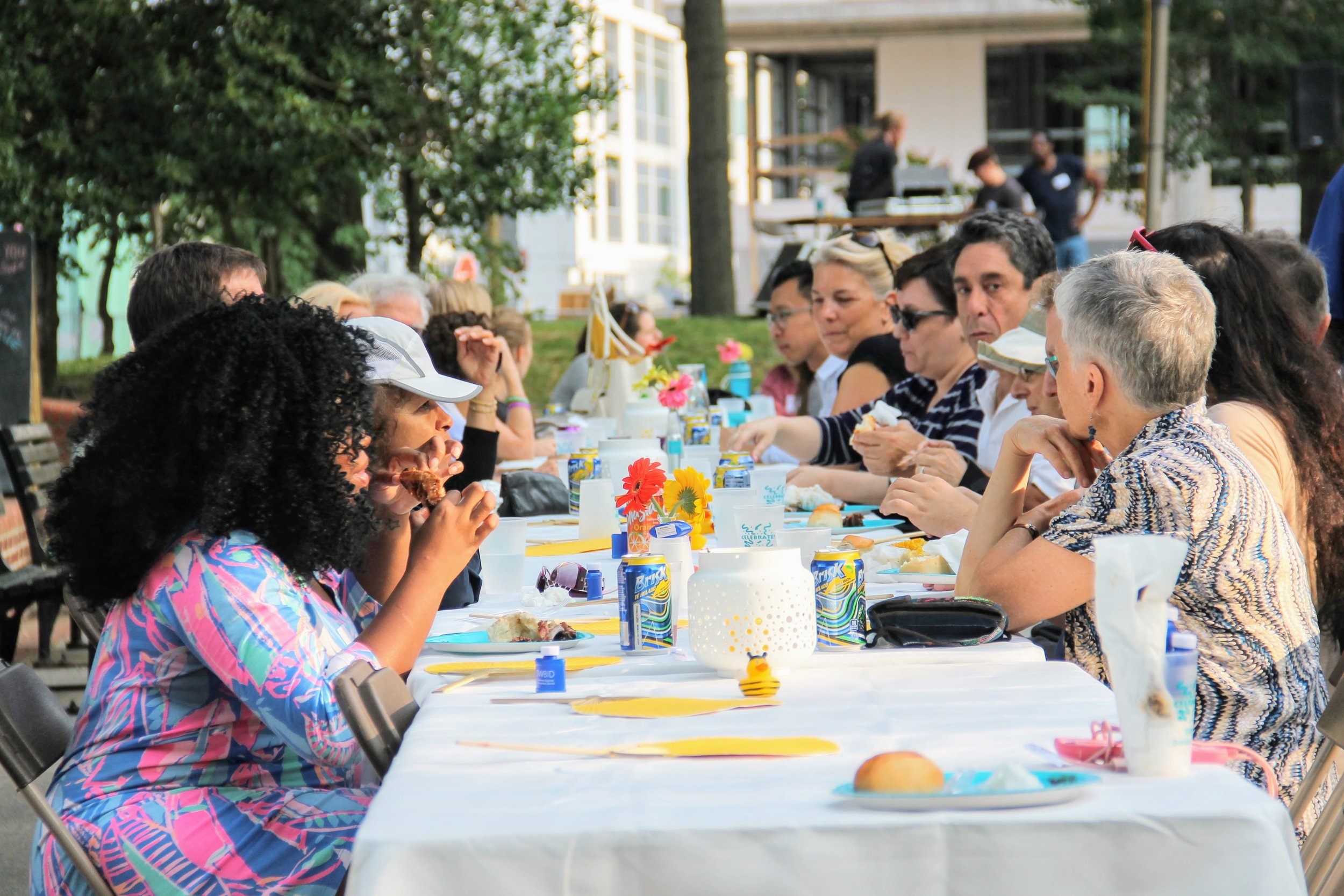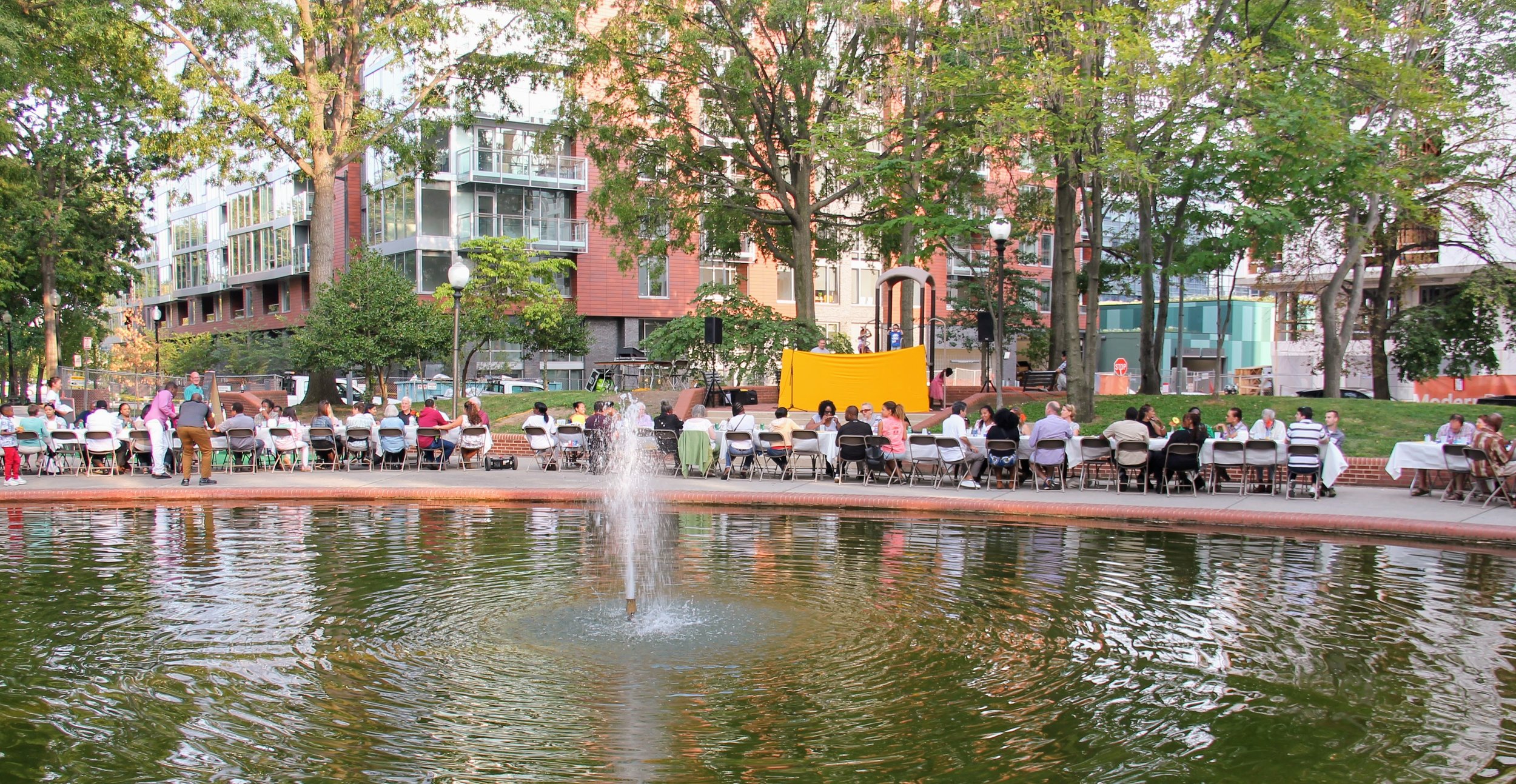I collaborate with people across disciplines and differences to create socially engaged artworks about American society and human flourishing. I apply relational thinking and an aesthetic of care and delight to constructing these artworks. Instead of objects, I create human connections using conversations and social interactions as my mediums.
50 Years of HOPE and HAHAs
Vagabond presents “50 Years of HOPE and HA-HAs,” the DMV’s first Vietnamese American art exhibition, celebrating the expansiveness of the diaspora. 2025 marks the 50-year anniversary of the end of the war in Vietnam. The mainstream perception of Viets has remained unchanged for decades, rooted in the suffering of war, yet nothing about our community is static.
In the 1967 speech “Beyond Vietnam,” Dr. Martin Luther King Jr. addressed the importance of understanding the Viet experience in saying, “we may learn and grow and profit from the wisdom of the brothers who are called the opposition.”
The exhibition features visual art, poetry, video art, zines and music by over 20 Viet artists including four zine collectives, offering counter narratives from the 1.5 and 2nd generation while uplifting the multi-cultural intersectionality of the diaspora. The theme of resilience is interwoven through joy, memorial, heritage, catharsis, solidarity, representation and community.
The exhibition title comes from Ocean Vuong’s poem, “The Last Dinosaur,” which asks how we can live better despite a destroyed past:
Oh wind-broke wanderer,
widow of hope & ha-has…
I was made to die
but I’m here to stay.
—Ocean Vuong
“The exhibit doesn’t just look back on 50 years. It also looks forward to everything that could happen in the next 50 years of Vietnamese history in America,” Pham Hughes says. “I find the “hope” in ‘Hope and HA-HA’s’ exciting.”
Hey, We Need To Talk! 2024
In this deeply divided era, one of the hardest things you can do is talk to someone who thinks differently from you. But that’s exactly what we need to do if we want to solve the social and political problems our country faces and if we want to create a society in which everyone flourishes. Strengthening our social bonds happens when we begin to care about each other again. That begins with a conversation.
Philippa Hughes transformed the Crumpacker Gallery at the University of Michigan Museum of Art into a social practice artwork that becomes complete when human connections happen. In this space, you are invited to have honest, caring, common-sense conversations. Weekly meals will take place in the gallery, bringing together people of different worldviews to find understanding with each other, explore what it means to be American, and envision a flourishing future together. This artwork was inspired by the work of U-M Professor Jenna Bednar, who proposes four pillars of flourishing: community, sustainability, dignity, and beauty. The artwork features wallpaper commissioned from Louise Jones (née Chen) who painted all the state flowers as a symbol of American unity and a metaphor for flourishing.
What participants are saying:
“I am in AWE of the genuine, warm, open, and welcoming conversation that took place through our meal. It was one of the most remarkably candid yet in-depth conversations I've ever had with people I've never met. It was an honor to hear and witness their stories and to be inspired by the shared sense of community that developed for all of us around the table.”
“It was just an amazing event. I think 'Hey, We Need to Talk' as a model for fostering community and conversation is exceptional.”
“Philippa Pham Hughes’s “Hey, We Need to Talk!” at UMMA is a fun way to dive into tough conversations. It creates a relaxed, intimate space to talk about what it means to be American, and despite having different political views, we all decided we wanted to stay in touch after so we could keep the conversation going and continue to learn and grow together.”
Around the Table
Around the Table is a group exhibition that engages the theme of food, not as a material or medium, but as a means of social interactions and communal round ups over meals. It features contemporary national and international artists whose works reference food as a metaphor of shared experiences, open conversations, and coming together.
Conceived as a series of separate yet interrelated installations and interventions, the aspirations of Around the Table are manifold: to explore the sensorial, social, and political significance of food; to spark earnest discussions across divisions; and to strengthen commonalities rather than differences among people.
Around the Table presents emblematic works by prominent artists Suzanne Lacy, Valeska Soares, Jo Smail, and Michael Rakowitz; new commissions by Jennifer Wen Ma, Helen Zughaib, Adam Silverman, and Monsieur Zohore; and social convenings by Philippa Pham Hughes. Although varied in their vocabularies, formal and conceptual, the featured works collectively aim to rise above the social polarization of our time, celebrating cultural diversity, multiplicity of viewpoints, and gathering “around the table.”
At heart multidisciplinary, Around the Table extends the conventional exhibition framework with a “menu” of participatory activations, performances, convenings, and talks by exhibiting artists, bringing the gallery setting to life as a space of communal experience and belonging.
Exhibition curated by Dr. Vesela Sretenović.
“Thank you for convening us in a delicious dinner and thoughtful questions. It was such a special night I will remember always.”
“Been simmering on our conversation deeply over the last few days.”
Vagabond
Almost 50 years post-war, the Vietnamese-American narrative is still skewed. 13 Vietnamese creatives have decided to change this vision. Vagabond is a Zine featuring interviews and other work with those artists, poets, photographers, designers, and musicians in the DMV area. Co-created by Philippa Pham Hughes and Anthony Trung Quang Le, Vagabond challenges mainstream American beliefs on what it means to be Vietnamese-American through the counter-narratives of its writers. In addition to their interview contributions, each artist was commissioned to write a letter to their younger self as an act of self-care. Vagabond is a powerful reminder of how far the Vietnamese American community has come while serving as a vessel of education to the public. The Zine celebrates rich Vietnamese American excellence through art and healing, a radical act of self-love for both the artists and the community.
Vagabond in its print form can be purchased online here or explored at vagabondzine.com. Additionally, the zine has an outdoor art exhibit located at Lost Origins Outside, viewable during the 2024 Summer.
“For me, being Vietnamese American was almost about reducing myself when I was growing up. Now it feels expansive. I’m double things.”
We Should Talk: A Series of Art Installations and Programming Powered by Asian American Women
We Should Talk is a series of multi-media art installations and programs in which multi-disciplinary Asian American women artists create space to explore the nuances and complexities of what it means to be an Asian American woman. We Should Talk is led by curator and artist Philippa Pham Hughes and artists Adele 이슬 Kenworthy and Xena Ni. We apply an aesthetic of care and delight to creating relational spaces in which we share deeply and honestly, learn from one another, explore, and flourish together.
This project received Federal support from the Asian Pacific American Initiatives Pool, administered by the Smithsonian Asian Pacific American Center.
-
The Greatest Poem featured the paintings and poetry of Thu Anh Nguyễn, a short, animated film produced by Philippa Pham Hughes called The Greatest Poem, and expressions of Asian American identity from AAPI women across the country that were turned into found poems by Thu Anh.
“A powerful project, “The Greatest Poem,” expands from considering the Asian American women’s experience to all who followed the road that led to this country, leaving behind all that shaped us—feeling here, there, but often in between. Philippa’s animated film explores the concept of identity with touching honesty. Along with the colorful flower mural, the exhibition sends a message of hope and optimism. So, yes, let’s all talk!” Maria Karametou
-
In May 2024, artist Xena Ni transformed Heurich House Museum into a portal to the future. Her interactive art installation, Good Fortunes, invited people to travel to the future with visionary Asian Americans and return with reasons for hope in the present.
As a visitor to Good Fortunes, you’ll enter a portal to the future made from mailboxes and cascades of red strings and bells. Inside one of the mailboxes is a message for you – a gift from the future sent to you by the visionary artists and organizers who traveled to the future with Xena to show you that America is still full of possibility, its future still able to be shaped by your hopes, visions, and actions.Your gift will include an invitation to write your own wish for the future and to send it to the future by ringing the portal bells. As visitors like you leave their own wishes for the future, Good Fortunes will grow into a vessel for sharing hope, curiosity, and dialogue about every person’s role in shaping the future.
-
For many Asian and Asian American families, fruit is shared as an act of love in abundance: often present at a child’s first birthday celebration in Korea called a doljanchi; given in oversized boxes as housewarming gifts; and placed at altars for even our ancestors to enjoy.
And in our transnational and intergenerational cultural memory, CUT FRUIT/과일깍자! asks what can spacializing love look like for generations to come? For the artist, it was memories of her umma cutting fruit.
CUT FRUIT/과일깍자! took place at the National Museum of Asian Art for Smithsonian’s annual Solstice Saturday celebration on June 22.
Adele cut fruit for people as artists Thu Anh Nguyen and Xena Ni invited them to 1 on 1 listening sessions. Visitors also had an opportunity to share their own stories of love and cut fruit.
Instead of signs listing prices per pound, CUT FRUIT/과일깍자! invited us to carry the questions asked between the peels and slices:
what is the first taste you can remember?
what is something you always wished someone had asked and knew about you?
what fruit carries your favorite memories?
who is allowed to gather?
who is allowed rest?
-
Around the Table is a group exhibition that engages a theme of food not as a material or medium, but as a means of social gatherings and communal round-ups. Exhibition curated by Dr. Vesela Sretenovic at the de la Cruz Gallery.
One of the greatest and hardest acts of civic engagement is talking to people who don’t share our beliefs. But that’s exactly what we need to do to create a society in which everyone flourishes. Strengthening our social bonds happens when we begin to care about each other again and develop relationships with one another. That begins with a conversation around the table. Each conversation begins with looking at one of the artworks in the exhibit and reflecting on race (Constructed Collages by Jo Smail), home (“Eat the News” by Helen Zughaib), and belonging (“BElonging” by Jennifer Wen Ma). Over dinner, we envision a future in which every human flourishes. Poet Thu Anh Nguyen writes poetry that embodies the words and emotions of each conversation. Chef Devin Murphy home-cooks each meal to nourish us.
“I have heard the word “phenomenal” more than a few times from various participants reflecting on the evening. From the beautifully inviting prompts, to the typewriter poets, to the graphic recording artist who captured the spirit of the night—every detail was just so well done. It was a beautiful and vital point of reconnection for our community!”
Hey, We Need To Talk! 2022
In partnership with the Ann Arbor City Clerk’s Office, the U-M Creative Campus Voting Project collaborated with the University of Michigan Museum of Art to turn the art museum into an election hub—people could register to vote, get their ballot, access voting resources, and celebrate participation. In addition, visiting artist Philippa Hughes hosted a dynamic and deeply engaging series of experimental social events across UMMA’s galleries, creating space for authentic and honest conversations between politically diverse people.
Treehouse
Treehouse was a collaborative, multi-disciplinary, interactive art experience inviting people into a space of beauty that encouraged wonder about the world and each other. We asked people to Imagine a world in which we could all flourish and connect to nature and one another. We created a portal for reflection, reconnection, remembrance, and dialogue.
“It is stunning. I was refreshed to have the quiet time to explore, after our animated conversation.”
The Greatest Poem
Walt Whitman believed that the power of poetry and democracy are derived from their capacity to make a unified whole from diverse and sometimes contradictory parts. He said, “The United States are the greatest poem.” As a Hybrid American who contains multitudes, I see myself reflected in Whitman’s words and those words inspired me to write “The Greatest Poem,” a declaration of what it means to me to be American, to be human, to be a poem. This film was commissioned by Shanara Gabrielle and Arena Stage and directed by Elyse Kelly. My words were brought to life by 20 amazing artists.
District Dreamers Film Fest, 2023
Florida Film Festival, 2023
DC Asian Pacific American Film Festival, 2022
London International Animation Festival, 2022
Mixed Asian Media Festival, 2022
Viet Film Festival, 2022
“It should be shown at schools everywhere. My daughter’s elementary school just had a World Bazaar to celebrate the many nations that are present at their school through heritage and it was just wonderful to see how all of these nations could be in the same room and also all be American.”
Looking for America
What does it mean to be American? How do different communities—in the Midwest, at the border, in cities, and in rural areas—answer that question? Across the United States, we’re inviting local artists and community members of all backgrounds and political stripes to come together to share their stories and perspectives.
“As you may imagine, the installations sparked conversation, laughter, mirth, and some contention. In other words, it was a success!” -Curator Erica Marin at the El Paso Museum of History
“Y’all count me in, the sooner we start seeing how much the same we are the sooner our lives will benefit.”
Ozark Story Project
A creative storytelling project focused on exploring the intersection of immigrant and traditional Ozark folklore through poetry, recipes, photos & recorded stories. Anyone that has a relationship to the Ozarks is invited to participate. Regardless of where you were born, where you live today, or how long you’ve lived here.
Your story matters.
“Your engagement with local artists, activists, and advocates have provided different perspectives and opened up connections on a deeper and more meaningful level.”
Blueberries + Cherries
Blueberries + Cherries invites politically diverse guests to break bread and talk to each other face-to-face over a home cooked meal. The goal: to understand the things that influence our votes and to find ways to bridge the vast ideological gap that plagues our country. We engage in civil discourse that is unfiltered by the lens of political punditry and by the anonymity and bias of social media.
“Even if it’s just a dinner, or a conversation with a small group, or a huge exhibit or big party, you’re impacting lives, in small and big ways and it’s so meaningful. I truly admire your persistence at building bridges and communities.”
Hello, Neighbor!
Residents of Southwest tell their own stories of life in their neighborhood in this series of video portraits. The Southwest neighborhood is filled with amazing people! Some have lived there for decades, some moved there more recently. Everyone loves how it feels like a small town within a big city where people say hello to each other and stop to ask how you’re doing. These video portraits capture a little of the spirit of Southwest.
A (Good) American
An art exhibit in which seven artists examined the immigrant experience in America and examined what it means to be a good American. The artists used the interior and exterior spaces of the Heurich House Museum, the historic home of 19th century German immigrant Christian Heurich, as backdrop and inspiration.
Van Ness Social Club
The Van Ness Social Club is new-fashioned town square and social gathering where neighbors young and old can get to know each other.
The Van Ness Main Street won a grant from AARP to create an intergenerational project that would improve the built environment and drive community engagement through placemaking. We created a conceptual social club centered around a new dance called the Van Ness Shuffle, which was choreographed by Sarah Oppenheim with information she gleaned from community meetings and research. We also created an engaging physical space filled with delightful furniture made by artists Joseph Orzal and James Cole to welcome residents of all ages to get to know each other in a fun and casual environment. The social club can pop up anywhere and anytime in the neighborhood.
SW Sunday Supper
Every Sunday in August, 2017 and 2018, neighbors came together to meet someone new and get to know one another over a meal. Each supper began with an artistic engagement. Hand dancing lessons by a group that dances every Saturday at the nearby recreation center, poetry recitation, improv theater, and a community talent show. Local restaurants provided the food. All expenses were paid by the SW Business Improvement District and The Art Island collaborated on the production.
If You Lived Here
On June 27, 1867, Reverend Richard Hall, pastor of Union Bethel Church (known today as Metropolitan A.M.E.), purchased lot number 5, Section 2 on Stanton Road, SE, the first one-acre lot sold in the new Freedmen’s community, but later renamed Hillsdale. For a down payment of $15.00 a purchaser was provided a wagon-load of lumber and instructions for building a “simple but good quality house.” Reverend Hall was a pioneer—the 375-acre neighborhood, deeded to the Freedmen’s Bureau, gave newly freed African Americans the opportunity to own land and build their own homes. This self-sufficient community grew and thrived, eventually having its own school, recreation areas, post office, churches, cemeteries, and markets.
If You Lived Here seeks to commemorate the founding of this community, and also to reflect on how we live today. Visitors will draw parallels between the past and the present through a series of interactive, tactile, and creative activities.
SEE / CHANGE
SEE / CHANGE is a video art installation that puts a human face on how population change and economic shifts affect neighborhoods and communities. The installation can be adapted to any neighborhood wishing to shine a light on its residents and connect them to one another.
In its first iteration, video portraits of community members were projected in storefronts along Lower Georgia Avenue NW for one week in November 2016. Mobile projections took place on a different wall each night. A series of interviews with residents telling their stories about the neighborhood were posted online. Discussions, workshops, and gatherings were hosted in locations throughout the neighborhood.
SUPERNOVA
SUPERNOVA Performance Art Festival showcased a powerful and lively line-up of public performance art in Rosslyn, VA. SUPERNOVA brought together more than 75 emerging and established local, national and international artists who took to the streets and parks to energize public spaces and engage audiences in unexpected ways. Presented by the Rosslyn Business Improvement District (BID) and produced by The Pink Line Project’s Philippa Hughes, SUPERNOVA activated Rosslyn’s raw spaces, office lobbies, rooftops, the Metro station, parks and public spaces.
LUMEN8Anacostia
The Lightbox—powered by The Pink Line Project—shined a celebratory spotlight on DC’s emerging creative community by hosting the launch party of the inaugural LUMEN8Anacostia festival, activating the former Metropolitan Police Department evidence warehouse in the Anacostia neighborhood of Washington, illuminating the arts, culture, and entertainment emanating from Ward 8 in our Our Nation’s Capital.
The Temporium
The Temporium, located in the former R.L. Christian Library at 13th and H streets NE, is an outgrowth of the D.C. Office of Planning's temporary urbanism initiative. “We want to activate vacant spaces and create lively neighborhood corridors throughout the city that would support creative entrepreneurs and highlight retail potential in emerging areas such as H Street,” said Tanya Washington, chief of staff at the Office of Planning.
“The city brought together a number of creative types, including Hughes, to brainstorm on the best uses for the empty spaces sprinkled about the District. Hughes championed the idea of establishing a short-term retail collective. These artist incubators are fairly common throughout New York and Los Angeles but have not become so on the D.C. design scene.”











